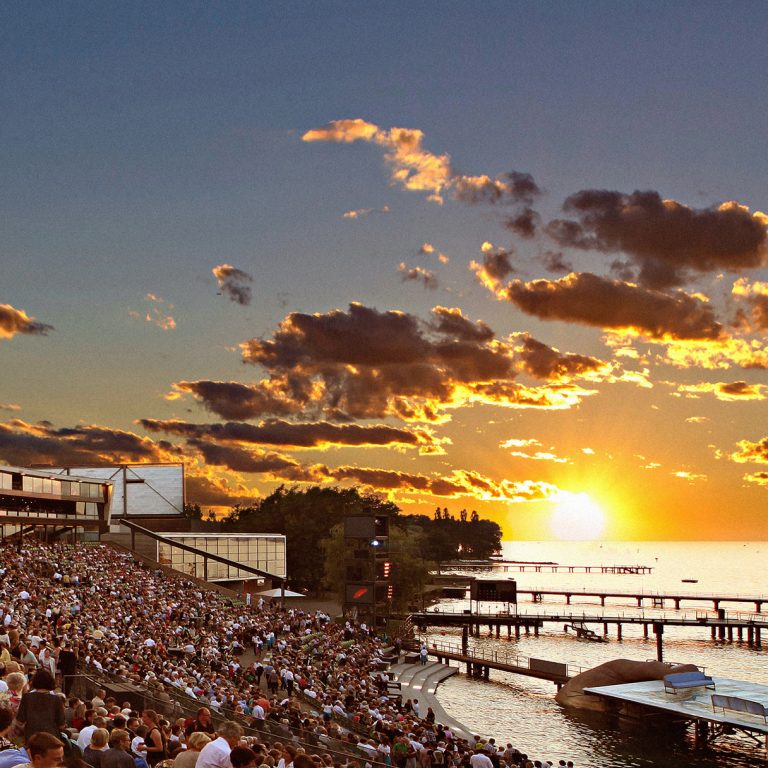
Sound worlds at Lake Constance
Bregenz Festival 2024: 17 Juli - 18 August 2024

Bregenz Festival 2024: 17 Juli - 18 August 2024
The lake stage in Bregenz is a venue for theatrical spectaculars
Freischütz
From 17 July to 18 August 2024, 27 performances of Der Freischütz are on the programme. Around a third of the 185,000 tickets issued (including dress rehearsal and Young People’s Night) have already been booked.
The Freischütz by Carl Maria von Weber has been one of the most popular operas in the German-speaking world since its premiere in 1821. It can now be experienced on the lake stage for the first time in summer 2024. Also involved: director and stage designer Philipp Stölzl and conductor in residence Enrique Mazzola, who will be working together again in Bregenz following the phenomenal success of Rigoletto.
Philipp Stölzl returns
Carl Maria von Weber’s Der Freischütz has been one of the most popular operas in the German-speaking world since its premiere in 1821 and yet has never before been performed on the Bregenz Festival’s lake stage. The romantic opera will celebrate its premiere on 17 July 2024, with advance ticket sales starting on 2 October 2023. Philipp Stölzl is responsible for the production and stage design, while Conductor in Residence Enrique Mazzola will conduct the music.
A ghostly little village on the lake stage
The stage set for Der Freischütz on Lake Constance in Bregenz is growing, and the number of tickets booked for the 2024 performance on the lake is also increasing: just over five months before the premiere of Der Freischütz on 17 July 2024, the Bregenz Festival is scheduling another performance on 8 August 2024 due to strong demand.
Images full of poetry and atmospheric landscapes ...
Opera at the Festspielhaus
The following day, a tense opera about love, trust and the impossibility of finding happiness in times of crisis will celebrate its premiere: Gioachino Rossini’s Tancredi. Jan Philipp Gloger will direct the production, while Yi-Chen Lin, who Bregenz Festival audiences will remember as the conductor of Giacomo Puccini’s Madame Butterfly, will conduct the music.
Orchestral concerts
Symphonic masterpieces and newly discovered sounds go hand in hand: the four orchestral concerts give an idea of the richness of music from the 19th century to the present day. With Ludwig van Beethoven’s Pastorale, Robert Schumann’s “Rhenish” and Gustav Mahler’s 1st Symphony, three of the most popular concert pieces are on the programme, complemented by works by Carl Maria von Weber, Antonín Dvořák and Igor Stravinsky as well as Emilie Mayer, who, dubbed the “female Beethoven”, achieved numerous successes with her compositions in the mid-19th century. While Enrique Mazzola as Conductor in Residence and Leo McFall as Chief Conductor of the Vorarlberg Symphony Orchestra are welcome guests, Giedrė Šlekytė and Petr Popelka as the new Chief Conductor of the Vienna Symphony Orchestra will make their debuts in Bregenz with a new choral-symphonic work by Thomas Larcher.
"Der Freischütz" by Carl Maria von Weberr
Lake Stage
Premier 17 July 2024, 9.15 p.m
28 Performances until 18 August
Tickets
Tickets for the entire festival programme:
Online Tickets 2024
Contact
Platz der Wiener Symphoniker 1 | 6900 Bregenz
Bregenz Festival
phone: +43 (5574) 4076